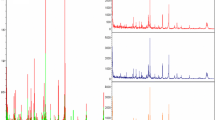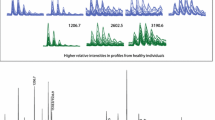Abstract
The N-glycosylation of proteins is one of the most important post-translational modifications relevant to various biological functions. The identification and quantification of N-glycoproteins in liquid chromatography–mass spectrometry (LC-MS) is challenging because of their low analytical sensitivity and selectivity. This is due to their microheterogeneity and the difficulty of synthesizing N-glycopeptides as an internal standard. Parallel reaction monitoring (PRM) is widely used in targeted LC-MS. The key advantage of LC-PRM is that it can identify N-glycopeptides using tandem mass spectrometry (MS/MS) fragmentation, even without an internal standard. We investigated the feasibility of analyzing N-glycoproteins using multiplex immunoprecipitation to improve sensitivity and selectivity. We targeted N-glycoproteins [α-fetoprotein (AFP), vitronectin (VTN), and α-1-antichymotrypsin (AACT)] that are abnormally glycosylated in hepatocellular carcinoma (HCC). Their tryptic N-glycopeptides were selected to determine the percentages of fucosylated N-glycopeptides using Y ions, which include glycopeptide fragments with amino acid sequences. Finally, we confirmed that the area under the receiver operating characteristic curve (AUC = 0.944) for the combination of AFP and VTN increased more so than for a single glycopeptide (AUC = 0.889 for AFP and 0.792 for VTN) with respect to discriminating between HCC and cirrhosis serum. This study shows that an LC-PRM method using multiplex N-glycoproteins immunoprecipitated from serum could be applied to develop and verify cancer biomarkers.

Graphical abstract




Similar content being viewed by others
Abbreviations
- AACT:
-
Alpha-1-antichymotrypsin
- AFP:
-
Alpha-fetoprotein
- AUC:
-
Area under the receiver operator characteristic curve
- CID:
-
Collision-induced dissociation
- CV:
-
Coefficient of variation
- Fuc:
-
Fucose
- HCC:
-
Hepatocellular carcinoma
- Hex:
-
Hexose
- HexNAc:
-
N-Acetylhexoseamine
- LC:
-
Liquid chromatography
- LLOQ:
-
Lower limited of quantitation
- LOD:
-
Limited of detection
- MS:
-
Mass spectrometry
- NeuAc:
-
N-Acetylneuraminic acid
- PRM:
-
Parallel reaction monitoring
- ROC:
-
Receiver operator characteristic
- TOF:
-
Time of flight
- VTN:
-
Vitronectin
References
Helenius A, Aebi M. Intracellular functions of N-linked glycans. Science. 2001;291(5512):2364–9.
Goupille C, Hallouin F, Meflah K, Le Pendu J. Increase of rat colon carcinoma cells tumorigenicity by alpha(1-2) fucosyltransferase gene transfection. Glycobiology. 1997;7(2):221–9.
Yao X, McShane AJ, Castillo MJ. Quantitative proteomics in development of disease protein biomarkers. In: Issaq HJ, Veenstra TD, editors. Proteomic and metabolomic approaches to biomarker discovery. London: Academic; 2013. p. 259–78.
Dalpathado DS, Desaire H. Glycopeptide analysis by mass spectrometry. Analyst. 2008;133(6):731–8.
Kurogochi M, Matsushista T, Amano M, Furukawa J, Shinohara Y, Aoshima M, et al. Sialic acid-focused quantitative mouse serum glycoproteomics by multiple reaction monitoring assay. Mol Cell Proteomics. 2010;9(11):2354–68.
Hong Q, Lebrilla CB, Miyamoto S, Ruhaak LR. Absolute quantitation of immunoglobulin G and its glycoforms using multiple reaction monitoring. Anal Chem. 2013;85(18):8585–93.
Benicky J, Sanda M, Pompach P, Wu J, Goldman R. Quantification of fucosylated hemopexin and complement factor H in plasma of patients with liver disease. Anal Chem. 2014;86(21):10716–23.
Yang N, Goonatilleke E, Park D, Song T, Fan G, Lebrilla CB. Quantitation of site-specific glycosylation in manufactured recombinant monoclonal antibody drugs. Anal Chem. 2016;88(14):7091–100.
Ruhaak LR, Kim K, Stroble C, Taylor SL, Hong Q, Miyamoto S, et al. Protein-specific differential glycosylation of immunoglobulins in serum of ovarian cancer patients. J Proteome Res. 2016;15(3):1002–10.
Dallas DC, Martin WF, Hua S, German JB. Automated glycopeptide analysis—review of current state and future directions. Brief Bioinform. 2013;14(3):361–74.
Peterson AC, Russell JD, Bailey DJ, Westphall MS, Coon JJ. Parallel reaction monitoring for high resolution and high mass accuracy quantitative, targeted proteomics. Mol Cell Proteomics. 2012;11(11):1475–88.
Gallien S, Bourmaud A, Domon B. A simple protocol to routinely assess the uniformity of proteomics analyses. J Proteome Res. 2014;13(5):2688–95.
Ronsein GE, Pamir N, von Haller PD, Kim DS, Oda MN, Jarvik GP, et al. Parallel reaction monitoring (PRM) and selected reaction monitoring (SRM) exhibit comparable linearity, dynamic range and precision for targeted quantitative HDL proteomics. J Proteome. 2015;113:388–99.
Gallien S, Bourmaud A, Kim SY, Domon B. Technical considerations for large-scale parallel reaction monitoring analysis. J Proteome. 2014;100:147–59.
Gallien S, Duriez E, Demeure K, Domon B. Selectivity of LC-MS/MS analysis: implication for proteomics experiments. J Proteome. 2013;81:148–58.
Cohen Freue GV, Borchers CH. Multiple reaction monitoring (MRM): principles and application to coronary artery disease. Circ Cardiovasc Genet. 2012;5(3):378.
Zhaojing M, Veenstra TD. Mass spectrometry–based approach for protein biomarker verification. In: Issaq HJ, Veenstra TD, editors. Proteomic and metabolomic approaches to biomarker discovery. London: Academic; 2013. p. 407–24.
Sanda M, Pompach P, Brnakova Z, Wu J, Makambi K, Goldman R. Quantitative liquid chromatography-mass spectrometry-multiple reaction monitoring (LC-MS-MRM) analysis of site-specific glycoforms of haptoglobin in liver disease. Mol Cell Proteomics. 2013;12(5):1294–305.
Anderson NL, Anderson NG. The human plasma proteome: history, character, and diagnostic prospects. Mol Cell Proteomics. 2002;1(11):845–67.
Hortin GL, Sviridov D. The dynamic range problem in the analysis of the plasma proteome. J Proteome. 2010;73(3):629–36.
Anderson L, Hunter CL. Quantitative mass spectrometric multiple reaction monitoring assays for major plasma proteins. Mol Cell Proteomics. 2006;5(4):573–88.
Whiteaker JR, Zhao L, Anderson L, Paulovich AG. An automated and multiplexed method for high throughput peptide immunoaffinity enrichment and multiple reaction monitoring mass spectrometry-based quantification of protein biomarkers. Mol Cell Proteomics. 2010;9(1):184–96.
Sano K, Asanuma-Date K, Arisaka F, Hattori S, Ogawa H. Changes in glycosylation of vitronectin modulate multimerization and collagen binding during liver regeneration. Glycobiology. 2007;17(7):784–94.
Hortin GL, Sviridov D, Anderson NL. High-abundance polypeptides of the human plasma proteome comprising the top 4 logs of polypeptide abundance. Clin Chem. 2008;54(10):1608–16.
Lee HJ, Na K, Choi EY, Kim KS, Kim H, Paik YK. Simple method for quantitative analysis of N-linked glycoproteins in hepatocellular carcinoma specimens. J Proteome Res. 2010;9(1):308–18.
Hwang H, Lee JY, Lee HK, Park GW, Jeong HK, Moon MH, et al. In-depth analysis of site-specific N-glycosylation in vitronectin from human plasma by tandem mass spectrometry with immunoprecipitation. Anal Bioanal Chem. 2014;406(30):7999–8011.
Mayampurath A, Song E, Mathur A, Yu CY, Hammoud Z, Mechref Y, et al. Label-free glycopeptide quantification for biomarker discovery in human sera. J Proteome Res. 2014;13(11):4821–32.
Arrieta O, Cacho B, Morales-Espinosa D, Ruelas-Villavicencio A, Flores-Estrada D, Hernandez-Pedro N. The progressive elevation of alpha fetoprotein for the diagnosis of hepatocellular carcinoma in patients with liver cirrhosis. BMC Cancer. 2007;7:28.
Debruyne EN, Delanghe JR. Diagnosing and monitoring hepatocellular carcinoma with alpha-fetoprotein: new aspects and applications. Clin Chim Acta. 2008;395(1–2):19–26.
Dela Rosa MA, Chen WC, Chen YJ, Obena RP, Chang CH, Capangpangan RY, et al. One-pot two-nanoprobe assay uncovers targeted glycoprotein biosignature. Anal Chem. 2017;89(7):3973–80.
Kim KH, Lee SY, Hwang H, Lee JY, Ji ES, An HJ, et al. Direct monitoring of fucosylated glycopeptides of alpha-fetoprotein in human serum for early hepatocellular carcinoma by liquid chromatography-tandem mass spectrometry with immunoprecipitation. Proteomics Clin Appl. 2018;12(6):e1800062.
Ordonez NG, Manning JT Jr. Comparison of alpha-1-antitrypsin and alpha-1-antichymotrypsin in hepatocellular carcinoma: an immunoperoxidase study. Am J Gastroenterol. 1984;79(12):959–63.
Ji ES, Hwang H, Park GW, Lee JY, Lee HK, Choi NY, et al. Analysis of fucosylation in liver-secreted N-glycoproteins from human hepatocellular carcinoma plasma using liquid chromatography with tandem mass spectrometry. Anal Bioanal Chem. 2016;408(27):7761–74.
Fu Q, Schoenhoff FS, Savage WJ, Zhang P, Van Eyk JE. Multiplex assays for biomarker research and clinical application: translational science coming of age. Proteomics Clin Appl. 2010;4(3):271–84.
Mazzara S, Rossi RL, Grifantini R, Donizetti S, Abrignani S, Bombaci M. CombiROC: an interactive web tool for selecting accurate marker combinations of omics data. Sci Rep. 2017;7:45477.
Zhu J, Warner E, Parikh ND, Lubman DM. Glycoproteomic markers of hepatocellular carcinoma—mass spectrometry based approaches. Mass Spectrom Rev. 2018.
Yuan W, Sanda M, Wu J, Koomen J, Goldman R. Quantitative analysis of immunoglobulin subclasses and subclass specific glycosylation by LC-MS-MRM in liver disease. J Proteome. 2015;116:24–33.
Zhu J, Chen Z, Zhang J, An M, Wu J, Yu Q, et al. Differential quantitative determination of site-specific intact N-glycopeptides in serum haptoglobin between hepatocellular carcinoma and cirrhosis using LC-EThcD-MS/MS. J Proteome Res. 2018.
Funding
This research was supported by the Creative Allied Project (CAP Research Grant No. NTM2371511) from National Research Council of Science and Technology, by the R&D Equipment Engineer Education Program from National Research Foundation of Korea (MSIP 2014R1A6A9064166), and by a Research Grant (No. T39710 to J.Y. K) from the Korea Basic Science Institute (KBSI).
Author information
Authors and Affiliations
Corresponding authors
Ethics declarations
We obtained all serum samples from the Samsung Medical Center (Seoul, Korea) with Institutional Review Board approval. Informed consent was obtained from human volunteers participating according to ethical standards.
Conflict of interest
The authors declare that they have no conflict of interest.
Additional information
Publisher’s note
Springer Nature remains neutral with regard to jurisdictional claims in published maps and institutional affiliations.
Electronic supplementary material
ESM 1
(PDF 428 kb)
Rights and permissions
About this article
Cite this article
Kim, K.H., Park, G.W., Jeong, J.E. et al. Parallel reaction monitoring with multiplex immunoprecipitation of N-glycoproteins in human serum for detection of hepatocellular carcinoma. Anal Bioanal Chem 411, 3009–3019 (2019). https://doi.org/10.1007/s00216-019-01775-5
Received:
Revised:
Accepted:
Published:
Issue Date:
DOI: https://doi.org/10.1007/s00216-019-01775-5




